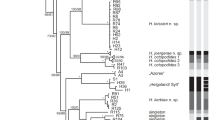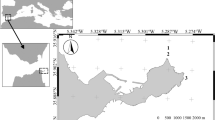Abstract
In contrast to typical planktonic hydromedusae, Cladonema medusae are mostly benthic, with specialised adhesive branches to adhere to the substrate. In this study, a Cladonema species discovered in a laboratory aquarium in Fuzhou, China, was confirmed as a new species, based on morphological and molecular analyses. The species was named Cladonema multiramosum sp. nov. Its medusa is distinct from that of congeners possessing substantially more adhesive branches (8–24, rarely 5–7), and tiny branches on the upper radial canals. The validity of C. multiramosumum sp. nov. was also supported by molecular phylogenetic analyses based on the mitochondrial 16S rDNA sequence. However, C. multiramosum sp. nov. medusa also displayed considerable phenotypic plasticity with respect to its radial canals, tentacles, stinging branches per tentacle, oral tentacles, manubrium, and gonads, hindering species identification based solely on morphology. Although some morphological characteristics of hydroids (filiform tentacles and medusa buds) and nematocysts could also be used as diagnostic characters in the genus Cladonema, this information is unavailable for some Cladonema species. Thus, the taxonomy within the genus Cladonema was re-evaluated based mainly on the morphological characteristics of the medusa. Further revision of the genus Cladonema should be made when supplementary information on the life cycle and DNA barcoding are updated.
Similar content being viewed by others
References
Bouillon J, Boero F, Seghers G. 1988. Notes additionelles sur les Hydroméduses de la mer de Bismarck (Hydrozoa-Cnidaria) II. Indo-Malayan Zoology, 5: 87–99
Bouillon J, Gravili C, Pagès F, et al. 2006. An introduction to Hydrozoa. Memoires du Museum National d’Histoire Naturelle, 194: 591
Bucklin A, Hopcroft R R, Kosobokova K N, et al. 2010a. DNA barcoding of Arctic Ocean holozooplankton for species identification and recognition. Deep-Sea Research Part II: Topical Studies in Oceanography, 57(1–2): 40–48
Bucklin A, Ortman B D, Jennings R M, et al. 2010b. A “Rosetta Stone” for metazoan zooplankton: DNA barcode analysis of species diversity of the Sargasso Sea (Northwest Atlantic Ocean). Deep-Sea Research Part II: Topical Studies in Oceanography, 57(24–26): 2234–2247
Cedeño-Posso C. 2014. First record of the genus Cladonema (medusae and polyps) in Colombia. Zootaxa, 3793(5): 597–599, doi: https://doi.org/10.11646/zootaxa.3793.5.8
Ender A, Schierwater B. 2003. Placozoa are not derived cnidarians: evidence from molecular morphology. Molecular Biology and Evolution, 20(1): 130–134
Farias G B, Leitão S N, De Castro Melo P A M, et al. 2020. First in situ record of the medusa stage of Cladonema radiatum (Cnidaria: Anthoathecata) in the South Atlantic Ocean. Ocean and Coastal Research, 68: e20349, doi: https://doi.org/10.1590/s2675-28242020068349
Folmer O, Black M B, Hoeh W R, et al. 1994. DNA primers for amplification of mitochondrial cytochrome c oxidase subunit I from diverse metazoan invertebrates. Molecular Marine Biology and Biotechnology, 3(5): 294–299
Fujiki A, Hou Shiting, Nakamoto A, et al. 2019. Branching pattern and morphogenesis of medusa tentacles in the jellyfish Cladonema pacificum (Hydrozoa, Cnidaria). Zoological Letters, 5(1): 12, doi: https://doi.org/10.1186/s40851-019-0124-4
Fujita S, Kuranaga E, Nakajima Y I. 2019. Cell proliferation controls body size growth, tentacle morphogenesis, and regeneration in hydrozoan jellyfish Cladonema pacificum. PeerJ, 7: e7579, doi: https://doi.org/10.7717/peerj.7579
Gershwin L A, Zeidler W. 2008. Cladonema timmsii, a new species of hydromedusa (Cnidaria: Hydrozoa) from a salt lake in South Australia. Zootaxa, 1826(1): 59–68, doi: https://doi.org/10.11646/zootaxa.1826.1.4
Ghory F S, Ali Q M, Ahmed Q. 2020. First record of Cladonema radiatum Dujardin, 1843 (Hydrozoa: Cladonematidae) from northern Arabian Sea, Pakistan. International Journal of Fisheries and Aquatic Research, 5(3): 14–16
Graziussi D F, Suga H, Schmid V, et al. 2012. The “Eyes absent” (eya) gene in the eye-bearing Hydrozoan Jellyfish Cladonema radiatum: conservation of the retinal determination network. Journal of Experimental Zoology Part B: Molecular and Developmental Evolution, 318(4): 257–267, doi: https://doi.org/10.1002/jez.b.22442
Guindon S, Dufayard J F, Lefort V, et al. 2010. New algorithms and methods to estimate maximum-likelihood phylogenies: assessing the performance of PhyML 3.0. Systematic Biology, 59(3): 307–321, doi: https://doi.org/10.1093/sysbio/syq010
He Jinru, Zheng Lianming, Zhang Wenjing, et al. 2015. Morphology and molecular analyses of a new Clytia species (Cnidaria: Hydrozoa: Campanulariidae) from the East China Sea. Journal of the Marine Biological Association of the United Kingdom, 95(2): 289–300, doi: https://doi.org/10.1017/S0025315414000836
Hirai E. 1958. On the species of Cladonema radiatum var. mayeri Perkins. Bulletin of the Marine Biological Station of Asamushi, 9(1): 23–25
Lindner A, Govindarajan A F, Migotto A E. 2011. Cryptic species, life cycles, and the phylogeny of Clytia (Cnidaria: Hydrozoa: Campanulariidae). Zootaxa, 2980(1): 23–36, doi: https://doi.org/10.11646/zootaxa.2980.1.2
Nawrocki A M, Schuchert P, Cartwright P. 2010. Phylogenetics and evolution of Capitata (Cnidaria: Hydrozoa), and the systematics of Corynidae. Zoologica Scripta, 39(3): 290–304, doi: https://doi.org/10.1111/j.1463-6409.2009.00419.x
Östman C. 1979. Two types of nematocysts in Campanulariidae (Cnidaria, Hydrozoa) studied by light and scanning electron microscopy. Zoologica Scripta, 8(1–4): 5–12
Östman C. 1982. Nematocysts and taxonomy in Laomedea, Gonothyraea and Obelia (Hydrozoa, Campanulariidae). Zoologica Scripta, 11(4): 227–241, doi: https://doi.org/10.1111/j.1463-6409.1982.tb00536.x
Östman C. 1987. New techniques and old problems in hydrozoan systematics. In: Bouillon J, Boero F, Cicogna F, et al, eds. Modern Trends in the Systematics, Ecology, and Evolution of Hydroids and Hydromedusae. Oxford: Clarendon Press, 67–82
Östman C. 2000. A guideline to nematocyst nomenclature and classification, and some notes on the systematic value of nematocysts. Scientia Marina, 64(S1): 31–46, doi: https://doi.org/10.3989/scimar.2000.64s131
Purcell J E. 2018. Successes and challenges in jellyfish ecology: examples from Aequorea spp. Marine Ecology Progress Series, 591: 7–27, doi: https://doi.org/10.3354/meps12213
Ralph P M. 1953. A guide to the athecate (gymnoblastic) hydroids and medusae of New Zealand. Tuatara, 5(2): 59–75
Raghu P R, Tampi P, Durve V. 1961. Note on the occurrence of the Anthomedusa cladonema in the Indian region. Journal of the Marine Biological Association of India, 3(1–2): 251–252
Rees W J. 1950. On Cladonema myersi, a new species of hydroid from the Californian Coast. Proceedings of the Zoological Society of London, 119(4): 861–865
Rees J T. 1979. The polyp and immature medusa stages of Cladonema californicum, Hyman, 1947 (Anthomedusae: Cladonemidae) with biological notes and a discussion of the taxonomy of the genus Cladonema. Journal of Natural History, 13(3): 295–302, doi: https://doi.org/10.1080/00222937900770231
Rees J T. 1982. The hydrozoan Cladonema in California: a possible introduction from East Asia. Pacific Science, 36(4): 439–444
Schuchert P. 1996. The marine fauna of New Zealand: athecate hydroids and their medusae (Cnidaria: Hydrozoa). New Zealand Oceanographic Institute Memoir, 106: 1–159
Schuchert P. 2006. The European athecate hydroids and their medusae (Hydrozoa, Cnidaria): Capitata part 1. Revue suisse de Zoologie, 113(2): 325–410.
Schuchert P. 2016. The polyps of Oceania armata identified by DNA barcoding (Cnidaria, Hydrozoa). Zootaxa, 4175(6): 539–555, doi: https://doi.org/10.11646/zootaxa.4175.6.3
Schuchert P. 2021. World Hydrozoa Database. Cladonema Dujardin, 1843. http://marinespecies.org/aphia.php?p=taxdetails&id=117049[2021-09-14]
Schuchert P, Hosia A, Leclère L. 2017. Identification of the polyp stage of three leptomedusa species using DNA barcoding. Revue Suisse de Zoologie, 124(1): 167–182
Takeda N, Deguchi R, Itabashi T. 2018. Reproductive strategies in marine Hydrozoan Jellyfish: sexual medusae and asexual polyps. In: Kobayashi K, Kitano T, Iwao Y, et al, eds. Reproductive and Developmental Strategies. Tokyo: Springer, 157–174
Tamura K, Peterson D, Peterson N, et al. 2011. MEGA5: molecular evolutionary genetics analysis using maximum likelihood, evolutionary distance, and maximum parsimony methods. Molecular Biology and Evolution, 28(10): 2731–2739, doi: https://doi.org/10.1093/molbev/msr121
Xu Zhenzu. 1993. Revisions of nominal species on the Hydromedusae of China sea areas. Journal of Oceanography in Taiwan Strait, 12(3): 197–204
Zheng Lianming, He Jinru, Lin Yuanshao, et al. 2014. 16S rRNA is a better choice than COI for DNA barcoding hydrozoans in the coastal waters of China. Acta Oceanologica Sinica, 33(4): 55–76, doi: https://doi.org/10.1007/s13131-014-0415-8
Zhou Taixuan, Huang Mingxian. 1958. A study on hydromedusae of Chefoo. Acta Zoologica Sinica, 10(2): 173–197
Zhou Konglin, Zheng Lianming, He Jinru, et al. 2013. Detection of a new Clytia species (Cnidaria: Hydrozoa: Campanulariidae) with DNA barcoding and life cycle analyses. Journal of the Marine Biological Association of the United Kingdom, 93(8): 2075–2088, doi: https://doi.org/10.1017/S0025315413000969
Acknowledgements
We thank Ruiting Li for her assistance in the culture of C. multiramosum. We thank editors and reviewers for their comments and suggestions on this manuscript. We would like to thank Editage (www.editage.cn) for English language editing.
Funding
The Fund of China Ocean Mineral Resources R&D Association under contract No. DY135-B2-13; the National Natural Science Foundation of China under contract No. 41806181; the Natural Science Foundation of Fujian Province, China under contract No. 2021J011042; the Program for Innovative Research Team in Science & Technology in Fujian Province University; the Talent Introduction Pre-research Project of Minjiang University under contract No. MJY20017.
Author information
Authors and Affiliations
Corresponding authors
Rights and permissions
About this article
Cite this article
Zhou, K., Gu, Y., Wang, L. et al. Discovery of Cladonema multiramosum sp. nov. (Cnidaria: Hydrozoa: Cladonematidae) using DNA barcoding and life cycle analyses. Acta Oceanol. Sin. 41, 44–52 (2022). https://doi.org/10.1007/s13131-021-1900-5
Received:
Accepted:
Published:
Issue Date:
DOI: https://doi.org/10.1007/s13131-021-1900-5




